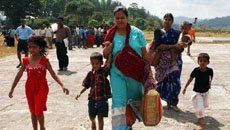An underwater earthquake rocked the lives of thousands of people on two tiny Indonesian islands March 28, just three months after a tsunami devastated the same region. The March 28 earthquake, which struck 200 miles south of the last quake, was recorded as having a magnitude of 8.7 on the Richter scale, which ranks it as one of the 10 most powerful earthquakes since 1900, according to the U.S. Geological Survey (USGS).
Three hundred thirty bodies have been found on Nias and Simulue, islands off the coast of Sumatra. The Indonesian government estimates that the death toll could reach 1,000, according to The New York Times – far less than the estimated 270,000 people killed by the tsunami the December quake caused.
The earthquake crumbled buildings and started fires on the two islands, but did not generate the disastrous waves of the Dec. 26 earthquake.
Scientists are debating why the quake did not trigger the same type of waves.
“This is a really important question,” Lori Dengler, a geologist at Humboldt State University in Arcata, Calif., told The Washington Post.
“The likeliest explanation would be that the ground didn’t move up enough. Not enough water was shifted. They’re still looking at it, though,” said Marlene McCauley, geology and earth sciences department. chair, who teaches a class on natural disasters.
The earthquake is a grave reminder of the instability in the area, which poses a constant threat to people living in countries that border the Indian Ocean.
“What happened today was not a surprise. A number of scientists have been talking about an increased likelihood of more earthquakes in this area because of the rupture that happened in December,” said Dengler.
“When you have a really big quake like the one in December, it’s going to release aftershocks,” McCauley said. “(The March 28 earthquake) is so big, experts will argue whether it should be called an aftershock, but it’s a semantic debate. The two earthquakes are related, no matter what.”
According to the USGS, earthquakes are caused by the pressure of plates of earth pushing against each other along fault lines – named locations where two plates of earth meet. The pressure of the colliding plates builds up stress that is stored in the earth.
“They are squeezing together over geologic time at about the rate your fingernails grow,” said Alan L. Kafka, a geophysicist at Boston College, to The Washington Post. “The movement causes tremendous amounts of force to build up and up and up.” Eventually, the plates slip, releasing the stress in waves that shake the ground.
McCauley notes that the Pacific is particularly vulnerable because of the number of fault lines and the way the plates interact – instead of behaving like most North American fault lines, which grind against each other in parallel lines, in the Pacific, the plates actually move under each other, creating greater stress.
Although it is impossible to predict the date of the next earthquake, scientists agree that the area will be hit again.
“Typically, when you have great quakes like this, it’s not the end. Typically you’ll have more,” McCauley said.
“It’s just a question of when,” Dengler said, “and how big.

